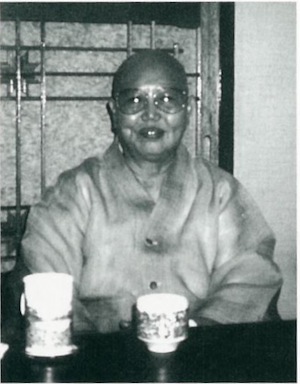
Venerable Daehaeng Sunim
Daehaeng Sunim is a famous healer. Born in 1926, she suffered great difficulties under the Japanese occupation of her country. She was ordained in her twenties and spent many years deep in the mountains practicing meditation. During this time she developed healing powers.
“My mind and the mind of a patient are not two. It is similar to electricity; one needs two coils to make light. In the same way, the mind of the patient and my mind combine together so there is energy. Who can we say heals whom? Because the two minds resemble the thread and the lamp that need to touch each other and combine to make light, when there is contact, automatically light comes. For this reason neither side can say they did it.
“The only thing we can say is that the Buddha healed. Is there anything that is not the Buddha? Inside the Buddha, there is the sentient being; inside the sentient being there is the Buddha. It reflects this way. Sometimes people ask me if the Way cures illnesses, but truthfully who is there to be cured of the illness? It is while somebody practices that they heal themselves.”
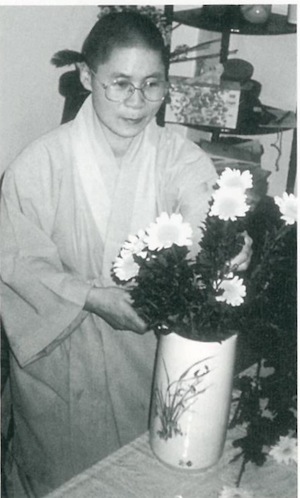
Venerable Pomyong Sunim
Pomyong Sunim lives in a city temple in the middle of Seoul and teaches flower arrangement. She entered the nunnery when she was five years old and very ill. Her family was afraid that she would die and they believed that only by sending her to a Buddhist temple could they ensure her survival. After recovering she stayed on because she liked the nunnery so much.
“Flower arrangement is not only putting flowers together. While I arrange flowers I meditate. When I do flower arrangement my mind is very peaceful as I forget everything. Even though I am a nun, I have troubles, too. When I arrange flowers, what I supervise, what I am researching, all the afflictions I might have in my heart, everything disappears.
“I not only tell [my students] how to put the flowers in the right place but also how to hold their mind and their body. It is a total training.”
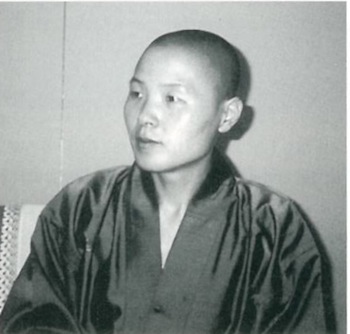
Venerable Jongmok Sunim
Jongmok Sunim is a disc jockey on a Buddhist radio station with a program of classical music. She is a fine singer and sometimes holds concerts, which are very popular.
“Music for me is connected to religious feelings, but not a definite religion. We have been born and we are living. How should we live? How can we live loving one another? I try to convey these feelings and questions through music. I would like to be a small lamp that illuminates, and I see music as a skillfull means whereby I can convey how to have love and compassion for other people.”
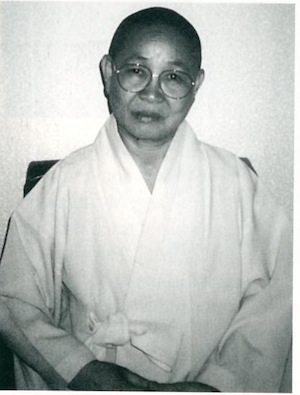
Venerable Jamin Sunim
Jamin Sunim, a widely respected nun of sixty, belongs to the Council of Elder Nuns in Korea and visits prisoners in jail.
“I went to jail without thinking much about it, as I had been asked to give only one dharma talk. However, when I saw the prisoners my view changed. Though some are hardened criminals, most have acted accidentally, or from necessity. They can assume the form of a criminal in a second, but it passes, disappears, and they look and remain very ordinary. Those who gathered to listen to my talk did not have the appearance of criminals whatsoever.”
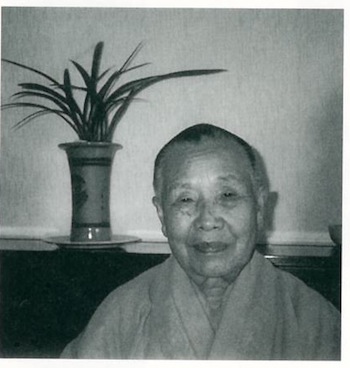
Venerable Okbong Sunim
Okbong Sunim is a Zen painter. Over the years she has had many exhibitions, and a book of her painting has recently been published.
“Painting is meditation for me. As soon as I pick up a brush, there is no difference from meditation. However many distracted thoughts might want to arise, there is no place for them to abide when I paint. My mind is empty of distractions, and there is only the painting being painted. It is meditation because there is only one thought. If one has meditated holding a hwadu (koan), one realizes that painting and holding a hwadu are not two different things. To hold a hwadu, or hold the intention to paint in one’s mind, is the same.”
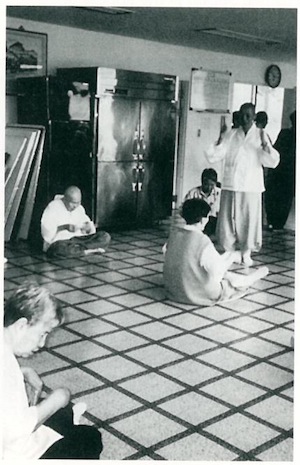 Venerable Myohi Sunim
Venerable Myohi Sunim
Myohi Sunim is the founder of a home for old nuns and women. She had to raise a lot of money to build this home and lives a very frugal life. Twice a day she helps the elderly ladies exercise for thirty minutes while listening to calisthenics on the radio. Afterward they have a little treat, like spice noodles or cakes.
“After ordination I started doing Zen meditation but after a while I thought that if I waited to save people until I was enlightened, when was I going to help them? I decided it would be better to help poor people directly, while transmitting to them the Buddha’s meaning in a warm manner. This place is for old women to practice and to become buddhas. Personally I cannot wait for my awakening to help other beings.”
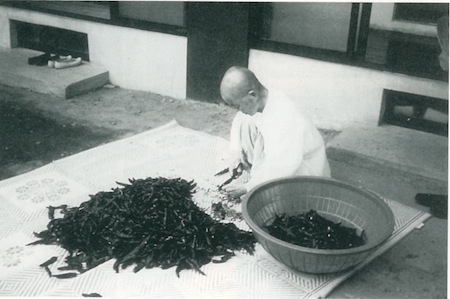
Venerable Haehae Sunim
Haehae Sunim is the abbess of Heunglyunsa nunnery, situated on the outskirts of Kyongju City, next to a very busy road. It was hosen as the site of a three-year retreat because the nuns preferred the sounds of traffic to those of tourists. Every day they sit for about ten hours.
Haehae Sunim has practiced for more than fifty years and is very accomplished. She claims not to know anything.
She does not wear socks, which is idiosyncratic for a Korean. “For the first twenty years I put all my effort in stopping the question (hwadu/koan) from running away. I did not take any responsibilities and did nothing but meditate. Cleaning my clothes was a hindrance, so I did not wash them till the midpoint of the three-month retreat, even in summer. We are suposed to wash our socks every day, but as soon as I began to wash them ‘What is it?’ would run away and other thoughts would come in. So I stopped wearing socks. Even in winter I only wore them outside and would take them off inside.”
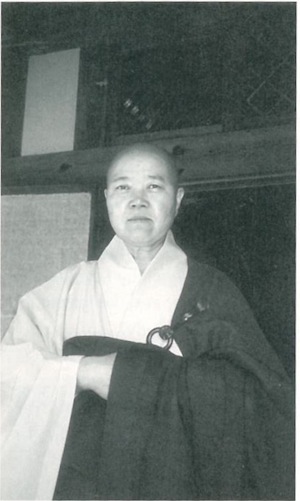
Myongsong Sunim, the Abbess of Unmunsa
Unmunsa is an extensive nunnery complex deep in the moutains of South Korea, where 250 nuns study, work the fields, and participate in a variety of social projects among the laity. Abbess Myongsong Sunim is widely respected as one of the foremost sutra lecturers in Korea.
“Since I was very small I have read a lot of religious books: Buddhist, Confucianist, Christian, even Socrates. I wanted to become a great sage. I became a nun when I was 23. We must know the real meaning of the Buddha before we meditate or pray. This is why I studied the sutras. I was not keen on becoming an abbess. My intention was to research and teach the sutras in the capital, Seoul. The nuns of Unmunsa asked me to become their lecturer and later, their abbess. But inspiration must come from within ourselves. If we hope to get inspiration from the outside—as if it was falling from the sky—this is wrong. It should be like water coming out of a source. From where else could we receive it?
“I tell all the nuns that they must become awakened beings. By their own accomplishments they become good, knowing advisors. They must know kowtow anywhere they go. We must all become great women of the Way.”
Text and photos compiled by Martine Batchelor, and made possible by a grant from the Korea Foundation, Seoul, Korea.
Thank you for subscribing to Tricycle! As a nonprofit, we depend on readers like you to keep Buddhist teachings and practices widely available.